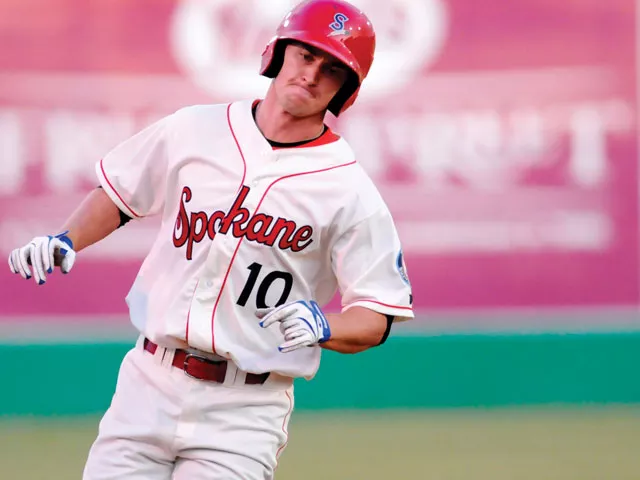
Minor league baseball. Even the name sounds so ... inferior. “Minor league” has that connotation in today’s parlance: cut-rate. Second-fiddle.
Not good enough.
Most often, when people refer to something as “minor league,” it’s with the assumption that things aren’t ever going to get any better: a permanent state of mediocrity. When you’re actually referring to minor league baseball, though, there’s another word you should add to the end of the last definition: not good enough yet.
It’s an expression that certainly applies to this year’s Spokane Indians, both as individual players and the team as a whole. The Indians opened their season with a pair of four-game losing streaks split by an 8-1 win against the redundantly named Vancouver Canadians. The reason for their struggles isn’t readily apparent, at least not after watching just one game. No one’s throwing the ball into the stands instead of hitting the cutoff man; the first baseman isn’t striding out to the batter’s box with his helmet on backwards. The troubles start and end with consistency.
“One night you’ll get pitching, but you don’t get hitting. The next night you’ll get defense, but we don’t get great pitching,” Manager Tim Hulett says. “You’ve got to put those things together.”
Authentic Baseball Checklist
There are certain expectations every fan has when going to a game, and while not all diamonds have cornfields for old-timers to emerge from, here are a few stereotypes the Indians manage to hit:
ZANY SPONSORSHIPS: From eyeball races (a certain section receives $500 off a medical eye procedure) to a fan catching a foul ball in the stands, just about every possible activity at the ballpark is “brought to you by” some corporation.
CHILDREN’S ACTIVITIES: Kids have plenty to do during the game, whether over in the “kids zone” behind the right-field wall or stepping out onto the diamond for one of the numerous between-innings contests.
TINNY SPEAKERS: It’s heartening to hear organ music (albeit pre-recorded) pumping up the crowd at times, though you’ll still have to suffer through all the “hits” of the ’80s and ’00s.
BUY ME SOME PEANUTS: The nostalgic ballpark favorites are all on sale, and for well less than half of what it would cost at a movie theater (which isn’t saying much, but still).
“ICE-COLD BEER, HERE!”: Whether you’re worried about the weather or the scoreboard, the itinerant beer man always has what you need.
The Indians certainly have the roster to contend on any given night. Shortstop Jurickson Profar, a 17-year-old prospect out of Curacao, can hit, field and throw — but then, he wouldn’t be playing professional baseball if he couldn’t do that. Hulett says what sticks out are Profar’s game awareness and highly tuned instincts. Especially when you consider he’s only a teenager.
Big 6-foot-2 third baseman Mike Olt provides some power at the plate, says hitting coach Brian Dayette, and Olt backed that up by knocking in a double and a triple in his first three games. In addition to his offensive prowess, he’s also an asset in the field. “For a big guy, he’s got some great feet, some good hands, and he can make some really good plays,” Hulett says.
Pitching coach Justin Thompson mentions Chad Bell, Zack Osborne and Jimmy Reyes as promising arms to watch. Though the trio has combined for zero wins and two losses thus far, Thompson still sees their upside.
“Once we get those guys stretched out and get their pitch count up, I think we’re going to contend,” says Thompson.
Whether pitcher or position player, the most important thing a minor-league player (assuming there are no gaping flaws in their fundamentals) gets out of a season is experience. The more innings they play, the more chances they have to further their development. But when looking at the feeder-system nature of the minor leagues, there would seem to be two conflicting forces driving a given team: getting wins and developing players. Hulett doesn’t see it that way. “Our focus is on developing winning players, because I think [winning and developing players] go hand-in-hand,” he says. “It’s hard to develop a player who goes through your whole system [and who] loses at every level and then say, ‘Go win at the big-league level.’” To a certain extent, using the term “minor league” in a derogatory tone makes sense even in a baseball context: As a whole, the team’s never really going to get all that much better. But that’s only because when the end of the season rolls around, the best players will be moving another rung up the ladder. The worst will find a different career.
And those who need a little more time will be back next year, ready to mix with another crop of guys starting out from scratch. They probably won’t be that good. At least, not yet.

















